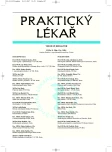Typical and atypical forms of Celiac disease in adults
Authors:
R. Štěpánek; P. Štěpánek-Firkal
Authors‘ workplace:
Soukromá praxe praktického lékaře a internisty, Divišov
Published in:
Prakt. Lék. 2007; 87(12): 739-740
Category:
Case Report
Overview
The gliadin fraction of wheat gluten leads, in celiac disease, to autoimmune damage of the anatomy and function of the mucous membrane of the small intestine; at the same time it leads to the production of blood-detectable antibodies against transglutaminase and gliadin. The prevalence of celiac disease is very high /1:100/. Non-identification of the disease, which occurs in 7 out of 8 cases, leads to impaired health and to malignant tumours, particularly lymphomas. Elimination of gluten from the diet results in normalization of the pathological findings without pharmacological intervention. The comparison of diagnostic expense and the consequent treatment makes celiac disease the most effectively treatable diagnosis in internal medicine. In the article, an atypical case of celiac disease in a young male is described.
Key words:
celiac disease, celiac sprue, gluten, malabsorption syndrome.
Labels
General practitioner for children and adolescents General practitioner for adultsArticle was published in
General Practitioner

2007 Issue 12
Most read in this issue
- Functional systems of the human brain
- Laparoscopic cholecystectomy for cholecystolithiasis and its complications. Retrospective 1-year analysis of 411 patients
- Intestinal tapeworms. Do they still exist? Are they still able to surprise us?
- Typical and atypical forms of Celiac disease in adults
